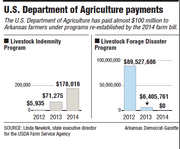When the 2012 drought sharply reduced the cattle population in Arkansas, producers were without protections that had been established years earlier. Two years later, they are receiving payments under rules established by the most recent farm bill.
Since April, the U.S. Department of Agriculture has paid Arkansas farmers$89.5 million for losses in 2012 and an additional $6.5 million for losses in 2013 and 2014 under the programs, said Linda Newkirk, state executive director for the USDA's Farm Service Agency, which administers the emergency assistance programs.
"I expect we're going to have a lot more to pay out," she said. "We still have a large number of livestock owners who have not come in yet."
Newkirk said her office has received 7,665 applications for aid under the programs for the retroactive time period. Nearly 7,000 of those applications and more than 93 percent of the payments are for losses in 2012 under the Livestock Forage Disaster Program.
Nationally, the USDA has made 150,000 payments to farmers and ranchers totaling more than $1.7 billion, USDA spokesman Kent Politsch said. The USDA estimated that it will pay $2.5 billion to farmers before the application deadline expires.
Producers have until Jan. 30 to apply for the Livestock Forage Disaster Program and the Livestock Indemnity Program for losses occurring between Oct. 1, 2011, and Feb. 7. Those programs provide payments for grazing losses because of drought and livestock deaths due to adverse weather.
Producers also can apply for the Emergency Assistance for Livestock, Honeybees and Farm-Raised Fish program for losses occurring in the same period. The program provides assistance for losses due to disease, weather and other losses not otherwise established by the farm bill.
The deadline to apply has been extended to Aug. 14. The program has a $20 million cap, making it much smaller than the other programs.
The three programs expired in 2011 and weren't renewed by Congress when the 2008 farm bill was extended in 2011. The 2014 farm bill made the programs retroactive to 2011 and changed the rules so producers are no longer required to purchase insurance to be eligible.
The majority of payments were made for 2012 because of the ferocity of the drought. By January 2013, the number of Arkansas cattle dropped to its lowest point since 1965, according to USDA data.
"Cattlemen who said they had cattle since they were 15 were losing their entire herds," said Zach Taylor, director of marketing for the Arkansas Agriculture Department. "What a lot of guys were doing at that time was selling their breed stock, the mamas. That's the last thing you want to sell. That's your moneymaker."
Producers could have bought insurance from the USDA's Risk Management Agency to help manage losses, but the program wasn't well publicized, he said.
"At a meeting we attended in 2012, a representative of the Risk Management Agency told us that only one policy had been sold in the whole state of Arkansas, and they didn't really have an agent that was pushing it at that time," Taylor said. "[Producers] didn't know about it. We ourselves didn't know about it."
Newkirk said the programs have provided relief to producers hurt by the April tornado. In her 37-year program career, she said this is the first time she remembers programs being in place that allow producers to apply and receive loss assistance so quickly.
"We were able to pay some of those producers for those losses immediately," she said. "We've had the program before, but payments have always been after the fact. With this farm bill, it was immediate."
Business on 08/02/2014
